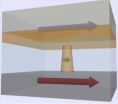(Press-News.org) Sometimes knowing that a new technology works is not enough. You also must know why it works to get marketplace acceptance. New information from the National Institute of Standards and Technology (NIST)* about how layered switching devices for novel computer memory systems work, for example, may now allow these structures to come to market sooner, helping bring about faster, lower-powered computers.
Switches based on transition-metal oxides have great potential as memory devices that retain their information even when the power is turned off. One type is made by stacking four different materials: a layer of copper and one of a metal oxide sandwiched between two metal layers that act as electrodes. Such systems can act as an on/off switch when a voltage is applied between the electrodes, but just why they behave as they do is a matter of debate.
Types of nonvolatile memory already exist—thumb drives make use of it—but they do not yet perform well enough to function as the working memory of a computer's central processor. If metal oxides can be perfected for this use, they could enable computers that boot up in seconds and use far less energy.
To study the switching mechanism, the NIST research team built its own version, but with a twist: They used ferromagnetic metals for the electrodes instead of the nonmagnetic metals typically used. They found that when an electric field is applied between the ferromagnetic electrodes, it causes the formation of tiny copper filaments that stretch through the metal-oxide layer. The filaments, about 16 nm long, are created or annihilated depending on the direction of the applied voltage through the electrodes, making or breaking the switch connection.
"The presence of such filaments is the only explanation that makes any sense as to why our structures make such good switches," says Curt Richter of NIST's Semiconductor Electronics Division.
One key to the team's discovery was their use of the physics of "spin"—a quantum property of electrons that has two possible values, either up or down. From the top electrode, the team sent a current made of electrons that had a polarized spin state, and they found that their spin state had not changed by the time the electrons reached the bottom.
"Only if a filament made of high-quality copper formed would the spins maintain their state," Richter says. "This finding was an end in itself, but it also suggests the layered structure could have applications in 'spintronics' where electron spin is used to carry and process information."
INFORMATION:
* H.-J. Jang, O.A. Kirillov, O.D. Jurchescu and C.A. Richter. Spin transport in memristive devices. Applied Physics Letters 100, 043510 (2012). DOI:10.1063/1.3679114, published online 26 January 2012.
NIST reveals switching mechanism in promising computer memory device
2012-02-24
ELSE PRESS RELEASES FROM THIS DATE:
Secondhand smoke results in graft rejection
2012-02-24
A new study published in the American Journal of Transplantation reveals that cigarette smoke exposure, in a cause-effect manner, results in graft rejection that would have been prevented by certain drug treatments.
Led by Zhenhua Dai, MD, PhD, of the University of Texas Health Science Center, researchers used mouse transplant models to investigate the impact of second hand smoke (SHS) on transplant survival and its mechanism of action.
Seven to eight mice per group were exposed to SHS and treated with or without immunoregulatory agents. They were exposed to SHS 4 weeks ...
President's Bioethics Commission posts additional documents related to its historical investigation
2012-02-24
Washington, D.C. –Today the Presidential Commission for the Study of Bioethical Issues posted on its website, www.bioethics.gov, hundreds of supporting documents related to its investigation into the U.S. Public Health Service (PHS) studies conducted in Guatemala in the 1940s. The documents include a spreadsheet that Commission staff painstakingly created to document the research subjects in Guatemala. In addition, the Commission has posted a Spanish translation of its report, "Ethically Impossible" STD Research in Guatemala from 1946 to 1948.
As the world is now aware, ...
A change of heart
2012-02-24
San Diego, Calif. – Beyond the personal tragedy of chronic alcoholism there is heartbreak in the biological sense, too. Scientists know severe alcoholism stresses the heart and that mitochondria, the cellular energy factories, are especially vulnerable to dysfunction. But they don't know the precise mechanism.
Now new experiments led by a team at the Wadsworth Center of the New York State Department of Health in Albany, and Thomas Jefferson University in Philadelphia, may provide insights into possible modes of heart damage from alcohol. The teams will present their findings ...
Medicare and Medicaid CT scan measure is unreliable according to new BWH study
2012-02-24
BOSTON, MA—Researchers at Brigham and Women's Hospital (BWH) have published findings that question the reliability of a new Centers for Medicare and Medicaid Services (CMS) quality measure. The study, "Assessment of Medicare's Imaging Efficiency Measure for Emergency Department Patients With Atraumatic Headache" finds that the CMS measure—an attempt to reduce computed tomography (CT) scans in emergency departments (ED)—does not accurately determine which hospitals are performing CT scans inappropriately.
The study is electronically published in the February 23, 2012 issue ...
Sam Houston State professor examines race and sentencing
2012-02-24
HUNTSVILLE, TX (2/23/12) – A Sam Houston State University professor is working on a series of studies that examine the effects of race and ethnicity on state and federal sentencing outcomes, including incarceration and sentence length decisions.
In his most recent research published online by Justice Quarterly, Dr. Travis Franklin, an Assistant Professor at the College of Criminal Justice, studied the sentencing of Native American offenders in federal courts. Using data from the United States Sentencing Commission for the years 2006-2008, he found that Native Americans, ...
New street drug 'bath salts' packs double punch
2012-02-24
San Diego, Calif. – The street drug commonly referred to as "bath salts" is one of a growing list of synthetic and unevenly regulated narcotics that are found across the United States and on the Internet. New research on this potent drug paints an alarming picture, revealing that bath salts pack a powerful double punch, producing combined effects similar to both methamphetamine (METH) and cocaine.
"This combination of effects is particularly novel and unexpected," said Louis J. De Felice of Virginia Commonwealth University's School of Medicine in Richmond. "Methamphetamine ...
Invade and conquer: Nicotine's role in promoting heart and blood vessel disease
2012-02-24
San Diego, Calif. – Cigarette smoke has long been considered the main risk factor for heart disease. But new research from Brown University in Providence, R.I., shows that nicotine itself, a component of cigarette smoke, can contribute to the disease process by changing cell structure in a way that promotes migration and invasion of the smooth muscle cells that line blood vessels. In particular, invading cells can remodel structures called podosomes, and this leads to further degradation of vessel integrity.
Ultimately, this cellular migration and invasion process gives ...
Microbes may be engineered to help trap excess CO2 underground
2012-02-24
San Diego, Calif. – In H.G. Wells' classic science-fiction novel, The War of the Worlds, bacteria save the Earth from destruction when the Martian invaders succumb to infections to which humans have become immune through centuries of evolution. If a team led by researchers at Lawrence Berkley National Laboratory's Center for Nanoscale Control of Geologic CO2 (NCGC) has its way, bacteria – with a little assist from science – will help prevent global destruction for real by trapping underground a greenhouse gas, carbon dioxide (CO2 ), that threatens Earth's climate.
The ...
Neurotoxins in shark fins: A human health concern
2012-02-24
MIAMI – (February 23, 2012) -- Sharks are among the most threatened of marine species worldwide due to unsustainable overfishing. Sharks are primarily killed for their fins alone, to fuel the growing demand for shark fin soup, which is an Asia delicacy. A new study by University of Miami (UM) scientists in the journal Marine Drugs has discovered high concentrations of BMAA in shark fins, a neurotoxin linked to neurodegenerative diseases in humans including Alzheimer's and Lou Gehrig Disease (ALS). The study suggests that consumption of shark fin soup and cartilage pills ...
A Rhode Island Hospital physician's experience in front-line field hospital in Libya
2012-02-24
VIDEO:
Adam Levine, M.D., an emergency medicine physician with Rhode Island Hospital and a volunteer physician with International Medical Corps, was deployed to a field hospital near Misurata, Libya, during the...
Click here for more information.
PROVIDENCE, R.I. -- Adam Levine, M.D., an emergency medicine physician with Rhode Island Hospital and a volunteer physician with International Medical Corps, was deployed to a field hospital near Misurata, Libya, during the conflict ...

